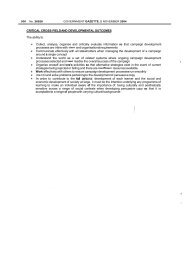Citizen Report Cards to Improve Service Delivery - South Africa ...
Citizen Report Cards to Improve Service Delivery - South Africa ...
Citizen Report Cards to Improve Service Delivery - South Africa ...
You also want an ePaper? Increase the reach of your titles
YUMPU automatically turns print PDFs into web optimized ePapers that Google loves.
Impact Evaluation of the <strong>Report</strong> <strong>Cards</strong><br />
Identifying and implementing incentives that give rise <strong>to</strong> a strong relationship of<br />
accountability between service providers and beneficiaries is viewed by many as critical for<br />
improving service delivery. How <strong>to</strong> achieve this, however, is less unders<strong>to</strong>od. Systematic<br />
evaluation of service delivery innovations <strong>to</strong> increase accountability can show what works,<br />
what doesn’t and why, a first step <strong>to</strong> scaling up successes.<br />
There are many different ways <strong>to</strong> evaluate a program/project, each subject <strong>to</strong> more or<br />
less serious constraints. An impact evaluation attempts <strong>to</strong> answer the counterfactual question:<br />
how would individuals or municipalities that participated in a program, for instance, the<br />
<strong>Report</strong> <strong>Cards</strong>, have fared in the absence of the program? The difficulty with this question is<br />
immediate: at a given point in time, an individual or municipality is observed <strong>to</strong> either be<br />
exposed or not exposed <strong>to</strong> the program. It is therefore not possible <strong>to</strong> obtain an estimate of the<br />
impact of the program on each individual or municipality. However, it may be possible <strong>to</strong><br />
obtain the average impact of the program by comparing participating municipalities (the<br />
treatment group) with a similar group of municipalities who are not exposed <strong>to</strong> the program<br />
(the control group). One implication of this is that an evaluation based on statistical methods<br />
requires are “large” sample. This is one reason why the <strong>Report</strong> Card project will take its<br />
starting point the municipal level.<br />
The problem facing an evalua<strong>to</strong>r is how <strong>to</strong> design the evaluation study so as <strong>to</strong><br />
establish a credible comparison group -- a group of municipalities who in the absence of the<br />
program would have had outcomes similar <strong>to</strong> those who were exposed <strong>to</strong> the program. This<br />
group should give us an idea of what would have happened <strong>to</strong> the members of the program<br />
group, if they had not been exposed <strong>to</strong> the <strong>Report</strong> Card, and thus allow us <strong>to</strong> obtain an<br />
estimate of the average impact on the group in question.<br />
To solve this problem, program evaluations typically need <strong>to</strong> be carefully planned in<br />
advance in order <strong>to</strong> determine which group is a likely control group. One credible way <strong>to</strong><br />
ensure that the treatment and comparison groups are similar is <strong>to</strong> select randomly from a<br />
potential population of participants (such as municipalities). If the sample is large enough, one<br />
can then be assured that, on average, those who are exposed <strong>to</strong> the program are no different<br />
than those who are not, and thus that a statistically significant difference between the groups<br />
in the outcomes the program was planning <strong>to</strong> affect can be confidently attributed <strong>to</strong> the<br />
program.<br />
To evaluate a program, one also needs <strong>to</strong> have a quantifiable outcome measure(s).<br />
This, in turn, requires knowledge of how the program possibly could influence outcomes. In<br />
this particular case, we require knowledge about how households with access <strong>to</strong> information<br />
on how the local providers, and/or local government, perform (and what citizens are entitled<br />
<strong>to</strong>) can possibly influence the services they receive. A necessary condition for this <strong>to</strong> be the<br />
case is that the local providers and/or local governments must be able <strong>to</strong> influence the<br />
outcomes that are measured and that one of the reasons the initial outcomes are suboptimal is<br />
related <strong>to</strong> choices made by the provider or local government (for example, budgets are spent<br />
on items not benefiting the intended beneficiary, or low effort is exerted in executing local<br />
programs).<br />
5
















